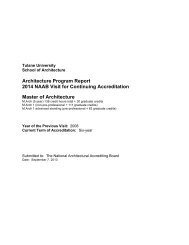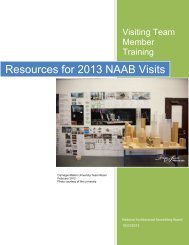Architecture Program Report Tulane University New Orleans ...
Architecture Program Report Tulane University New Orleans ...
Architecture Program Report Tulane University New Orleans ...
You also want an ePaper? Increase the reach of your titles
YUMPU automatically turns print PDFs into web optimized ePapers that Google loves.
PREAMBLE<br />
As an aid to the Accreditation Review Process the School of <strong>Architecture</strong> has<br />
elected to formulate an overview of the program’s curricular goals and content.<br />
This overview is followed by the Student Performance Criteria.<br />
It should be noted at the outset that the <strong>Tulane</strong> School of <strong>Architecture</strong> is a<br />
relatively small program housed within a private university. While there are<br />
clearly benefits to such a program, there are also limitations to the size and<br />
offerings of the curriculum. Hence, rather than write courses that only treat<br />
certain areas of specialization within the broader scope of architecture, TSA has<br />
worked to array as many of the requirements outlined below across the<br />
curriculum. In order to maximize the student’s learning and experience, the<br />
faculty (with only a few exceptions) teach in one primary subject area and in<br />
design studio. This ensures a saturation of material rather than a series of<br />
specialized subheadings subservient to or in addition to the Design Studio<br />
curriculum. In addition, all design faculty are required to have received training<br />
in a professional architecture degree program and many, if not most, are actively<br />
engaged in practice. Therefore, the culture of practice, coupled with the<br />
academic requirements of a university-based discipline, infuses the substance of<br />
the curriculum. There is also concomitant attention paid to the need to integrate<br />
the curricular areas into a comprehensive whole: the requirement of several<br />
“comprehensive studios,” as well as the attention paid to problems of the built<br />
environment evidence the commitment to the discipline and practice of<br />
architecture<br />
CURRICULAR GOALS AND CONTENT<br />
As has been noted throughout the <strong>Architecture</strong> <strong>Program</strong> <strong>Report</strong>, the overarching<br />
pedagogical intention is the synthesis of curricular areas. However, there are<br />
particular goals and content relative to the various subjects. To better aid in the<br />
evaluation of the curriculum, the goals and content of specific subject areas are<br />
outlined in brief below. While not substantially different in content from the<br />
Masters of <strong>Architecture</strong> Undergraduate <strong>Program</strong>, the Masters of <strong>Architecture</strong><br />
Graduate <strong>Program</strong> is compressed into three and one-half years. The shift to a<br />
single degree nomenclature in 1999 maintained the difference in years of<br />
education required for the degree.<br />
First-year<br />
For the School of <strong>Architecture</strong>, the Design Studio is the primary location for the<br />
synthesis of the myriad curricular issues; it is essentially the ‘center’ of the<br />
curriculum. <strong>Architecture</strong> is a highly interdisplinary discourse, combining information<br />
from a broad range of sources (i.e. the arts, history, technology, business), and the














